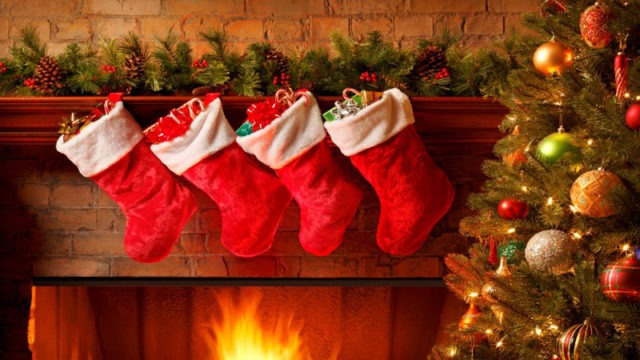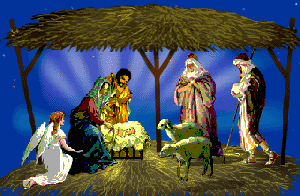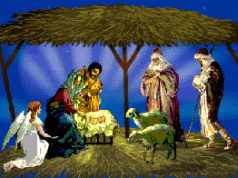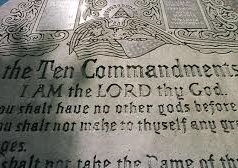CHRISTMAS TRADITIONS
THE CRIB
During Christmas, many Churches display a Crib or creche (nativity scene). It shows figures of Mary and Joseph praying over the infant Jesus in the stable. Figures of Magi, shepherds, kings, angels, and various animals surround the holy family. It is assumed that the Crib making custom came into existence of setting up miniature reproductions of the Christmas scene dates back to 8th century. A wall decoration in 380 A.D. was done in a Christian burial chamber. It was discovered in St. Sebastians Cata combs, Rome in 1887. The oldest crib is a marble one carved by Arnolfo di Cambio,probably in 1232 A.D. The statues are life size.The credit of popularising the re-enactment of the birth of Christ as a part of Christmas observance goes to St. Francis of Assis who was disturbed by the ignorance of the people of middle ages. He visited Rome in 1223 and showed his desire to Pope Honorius III of making a scenic representation of the site of nativity. With his consent, he constructed a crib at Greccio and placed in the figures. In the Greccio church, Francis made the scene of nativity and instructed chosen ones to impersonate Joseph, another Mary etc. and made a Life sized wax figure of Baby Jesus in the manger. Francis related the story of the first night and this novel ceremony was then repeated year after year. Custom of making home cribs became popular too in Europe after 1600 and in Italy, the celebration became a sport as people visited each other’s cribs and spent huge sums of money on them, in a competitive spirit. In France, children go to woods, sing carols, gather Holly, berries, moss and then build the crib lining the manger with holy hay. On Christmas eve, the crib is surrounded by candles which are lighted every evening till the feast of the Epiphany (12th day after Christmas – 6th January – also the day when Jesus was baptised).In Spain, on Christmas Eve, every house is adorned with cribs as this day it is believed, Mary blesses every home which she finds a picture of her son. In some places, it symbolise the fact that all in the family live in peace and harmony. In India, cribs are made in variety of forms, most of them reflect the stable of Bethlehem.
CHRISTMAS TREE

HOLLY
An evergreen tree with sharply pointed glossy leaves and bright red berries. Used in making Christmas wreaths and other decorations. Early Christians decorated churches with Holly during christmas time. The needlelike points of leaves were thought to resemble the crown of thorns that Jesus was forced to wear at the time of crucifixion. The red berries symbolise the drops of blood he shed.
MISTLETOE
An evergreen plant with dark leaves and white berries. Ancient Celtic priests considered the plant sacred and gave people sprigs of it to use as charms. The custom of decorating homes with mistletoe probably came from its use as a ceremonial plant by early Europeans in many countries, a person standing under a sprig of mistletoe may be kissed by someone of the opposite sex.
CANDLE
Light was an important part of the pagan midwinter festivities, since this was the time when the sun ceased to wane and began to grow stronger and brighter. In imitation candles and bonfires helped to drive away the forces of cold and darkness. Wax tapers were given as gifts at the Roman festival of Saturnalia. To the Christian community, the lighting of candles took on the additional symbolic significance of Jesus as the Light of the World. Christmas candles are made in all shapes, colors and sizes and are very often scented as balsam and evergreen. The beautiful idea of Christmas candles shining from windowsis a custom still practiced in Europe. In Sweden, St. Lucy appears wearing a crown of candles. In Victorian England, tradesmen made annual gifts of candles to their loyal customers. In many parts of the world , the Advent candles reflect the dawning season and remind us of the coming Light. The addition of lighted candles to the paradise tree marked the birth of our most beloved Christmas tree. The Christmas candle, with its brightness, sacredness and sense of well-being, is an indispensable part of the Christmas season.
BETHELEHEM LILY – CHRISTMAS ROSE
This is the legend of a beautiful flower that blooms at midnight only. Known as Christmas Rose, Heleborus in Latin and grows freely in Western Asia and Southern Europe. There are a dozen varieties with which bear flowers of different hues. The Lily white in tint has a legend woven around that once, a girl name Madelon had a shepherd brother who went at the behest of the angels to pay homage to the child Jesus on the first day of the Christmas day. Madelon followed them but on reaching there, found that every visitor had taken some gift for the Babe of Bethlehem but she was empty handed. She turned back aching heart, sobbing when Angel Gabriel appeared in resplendent glory. The Angel heard her woes and brushed the ground with shining wings and lo, and behold, appeared before the child’s wonder struck eyes, the loveliest of white flowers. Hugging the flowers to her breast, Madelon rang back to the stable where the child lay wrapped up amidst coarse straw. As she arrived, the three Kings Balthazar, Gaspar and Mechior reached there with their opulent gifts and attire; the first named with Myra signifying immortality, second frankincense, symbol of divinity and the third gold, the symbol of royalty. It is said that the child Jesus, with a scintillating smile stretched out his tiny little hands to accept the white flowers from Madelon homage holding hands. From that day onwards, it is believed that White Lily – Heleborus – Christmas Rose has its significance.
ADVENT CALENDAR
The Advent calendar originated in Germany and Scandinavia, but it has now become very popular in America as well. Sometimes it is the picture of a house with windows that can be opened to reveal the tiny pictures behind them. Other times it is a picture of a typical Christmas scene or snowcape with perforated areas that can be removed or opened, again to reveal the pictures behind. There is one window or flap for each day of Advent, the season before Christmas or, sometimes one for each day of December leading up to Christmas. Each day, the children are allowed to reveal one picture. The picture thus revealed are of toys or Christmas scenes. The last and largest picture is revealed on December 25th. It is the nativity scene, which gives meaning to all the joy and fun that the other pictures represent.
ADVENT WREATH
The Advent wreath is of Lutheran origin, but its sense of joyous anticipation has made it popular with many other religious groups in England and America. It is an evergreen wreath with four candles set in holders attached to it. Beginning four Sundays before Christmas, on the first Sunday of Advent, one candle is lighted each week as a symbol of light that will come into the world with the birth of Jesus. On the last Sunday before Christmas, all four are lighted to give a radiance to the church altar or the dining room table, wherever one wishes to set up the wreath. In some countries, Advent candles are similarly burned each week, but without being set in a wreath.
BELLS
The ringing of bells at Christmastime is a holdover from pagan mid-winter celebrations. When the earth was cold and the sun was dying, evil spirits were very powerful. One of the ways to drive them off was by making a great deal of noise. As making a great deal of noise was also rather fun, the noisemaking ceremonies were entered into with much good will. Bells were a very useful part of this, you could play a bell and shout or sing at the same time. Today the church bells ring throughout the world on Christmas Eve, not to drive evil spirits away, but to welcome in the spirit of Christmas with a joyful noise. In Scandinavia, bells signal the end of work and the beginning of festivity. In England, the tolling of devil’s knell welcomes the birth of Christ. In Italy and Spain, it signals the Midnight Mass.
CHIMNEY
In Scandinavia and Germany Santa comes on 24th December, knocking the door like normal people. In England and America the visit is secret and thus the entrance must be special, the chimney. Santa is said to have dropped the bag of money into the Stockings through the chimney.
KIDSFREESOULS WISHES ALL READERS
‘A HAPPY NEW YEAR’
MAKE NEW YEAR RESOLUTIONS – KEEP THEM FIRM










